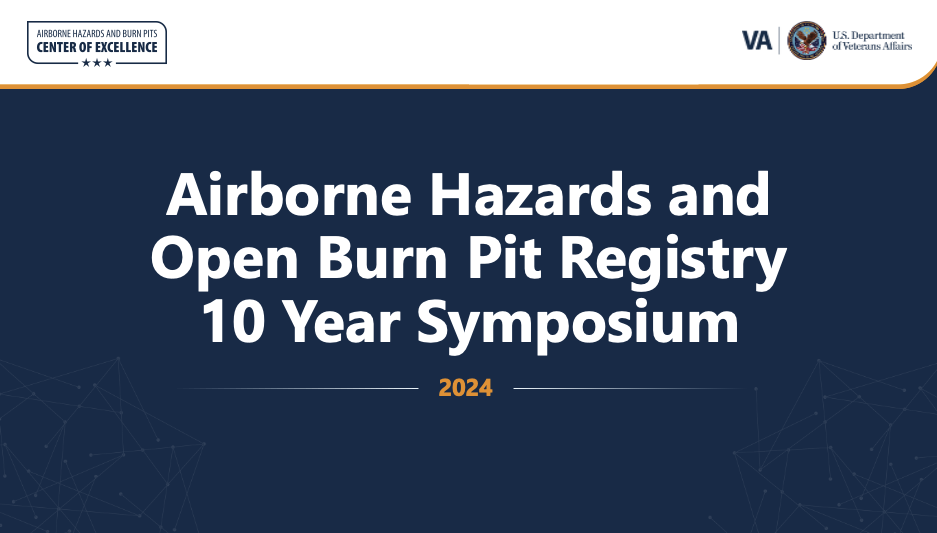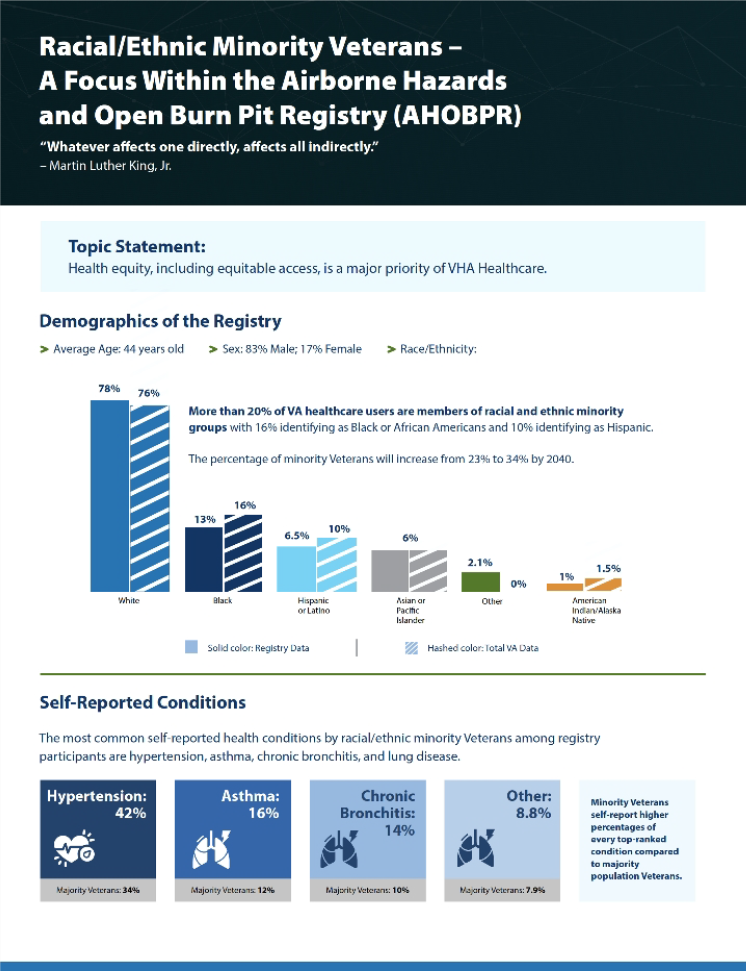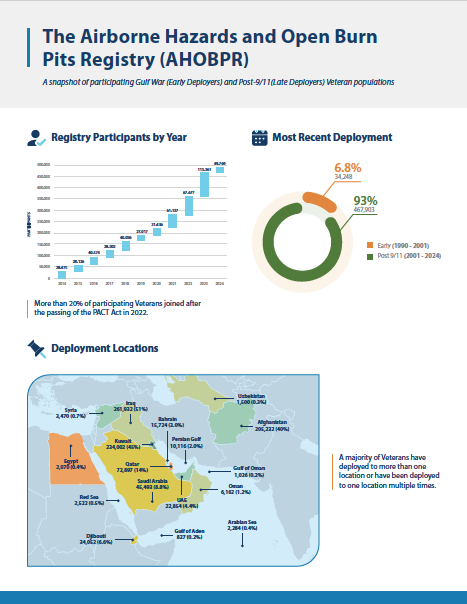Attention A T users. To access the menus on this page please perform the following steps.
1. Please switch auto forms mode to off.
2. Hit enter to expand a main menu option (Health, Benefits, etc).
3. To enter and activate the submenu links, hit the down arrow.
You will now be able to tab or arrow up or down through the submenu options to access/activate the submenu links.
Locator
Contact
Search
VA »
Health Care »
War Related Illness and Injury Study Center
»
The VA Airborne Hazards and Open Burn Pit Registry
War Related Illness and Injury Study Center
The VA Airborne Hazards and Open Burn Pit Registry
The VA Airborne Hazards and Open Burn Pit Registry
Understanding the Effects of Airborne Hazard Exposure
VA established the Airborne Hazards and Open Burn Pit Registry (AHOBPR) in 2014 to put data to work for Veterans and help us understand the potential health effects of airborne hazard exposures. Veterans are automatically enrolled in the Registry based on their DoD records. By maintaining participation in the AHOBPR, Veterans can provide information that supports ongoing research and surveillance. It can also help them discuss health concerns with their providers and get follow-up care.
AHOBPR Redesign
On August 1, 2024, the VA and Department of Defense (DoD) announced the launch of the redesigned AHOBPR. The redesigned Registry includes broadened eligibility criteria, automatic enrollment based on DoD records, and the ability for Veterans to opt out of participation if they wish. Opting out will remove your name from any Registry-related medical surveillance and outreach conducted by VA researchers.
About the Registry
Veterans and service members who served in the following military campaigns or locations, per DoD records, will be automatically enrolled in the updated Registry.
- Operations and Campaigns: Desert Shield and Desert Storm (ODS/S); Iraqi Freedom (OIF); Enduring Freedom (OEF); and New Dawn (OND).
- Iraq, Afghanistan, Kuwait, Saudia Arabia, Bahrain, Djibouti, Gulf of Aden, Gulf of Oman, Oman, Qatar, United Arab Emirates, waters of the Persian Gulf, Arabian Sea, Red Sea, Syria, UIzbekistan, and Egypt between August 2, 1990, and August 31, 2021
- Somalia since August 2, 1990
- The Southwest Asia theater of military operations and Egypt any time after August 2, 1990
- Afghanistan, Djibouti, Jordan, Lebanon, Syria, Uzbekistan, or Yemen any time after September 11, 2001
- Associated airspaces with the countries listed above as well as the waters of the Persian Gulf, Arabian Sea, Gulf of Aden, Gulf of Oman, and the Red Sea
Using the Registry to Support Ongoing Research
The Airborne Hazards and Burn Pits Center of Excellence is responsible for the daily operations of the Airborne Hazards and Open Burn Pit Registry. We provide surveillance to monitor trends in the Registry regarding enrollment and self-reported health conditions. Additional VA data is merged with the AHOBPR to conduct clinical and large data research.
Researchers utilize data from the Registry to identify trends that could lead to further research questions and studies or provide clinical implications. Integrating data from the Registry enhances the work we're able to do to understand the long-term effects of airborne hazard exposures. We facilitate this research and further data access and analysis capabilities through the AIMES Collaboration.
Researchers utilize data from the Registry to identify trends that could lead to further research questions and studies or provide clinical implications. Integrating data from the Registry enhances the work we're able to do to understand the long-term effects of airborne hazard exposures. We facilitate this research and further data access and analysis capabilities through the AIMES Collaboration.
The AIMES Collaboration
To support the data access and analysis needs of the VA using the AHOBPR and VA medical record data, the Center established the AIMES Collaboration.
The AIMES team brings expertise in data management and analysis, implementation science, and quality improvement to the management and use of the AHOBPR. Activities of the Collaboration include supporting:
The AIMES team brings expertise in data management and analysis, implementation science, and quality improvement to the management and use of the AHOBPR. Activities of the Collaboration include supporting:
- Development and design of the AHOBPR data reports to VA Central Office, regional networks, and medical centers
- The AHOBPR data needs of VA researchers through the AHBPCE
- Ongoing analysis of AHOBPR data for AHBPCE
The VA AHOBPR 10 Year Anniversary Symposium
To commemorate the Center's 10-year anniversary in June 2024, the AHBPCE and AHOBPR teams came together to discuss a decade of data, impact, and research. Click below to watch featured videos from the event.
Research Infographics
AHOBPR Publications
Publications:
- Burn Pit Emissions Exposure and Respiratory and Cardiovascular Conditions Among Airborne Hazards and Open Burn Pit Registry Participants - PubMed (nih.gov)
- Associations Between Self-Reported Burn Pit Exposure and Functional Status, 1990-2021 - PubMed (nih.gov)
- Barriers and Facilitators to Administering Burn Pit Registry Exams in VHA Facilities - PubMed (nih.gov)
- Blast Injury and Cardiopulmonary Symptoms in U.S. Veterans: Analysis of a National Registry - PubMed (nih.gov)
- Postdeployment Respiratory Health: The Roles of the Airborne Hazards and Open Burn Pit Registry and the Post-Deployment Cardiopulmonary Evaluation Network - PubMed (nih.gov)

















 Women Veterans Enrolled in the Airborne Hazards and Open Burn Pit Registry
Women Veterans Enrolled in the Airborne Hazards and Open Burn Pit Registry








